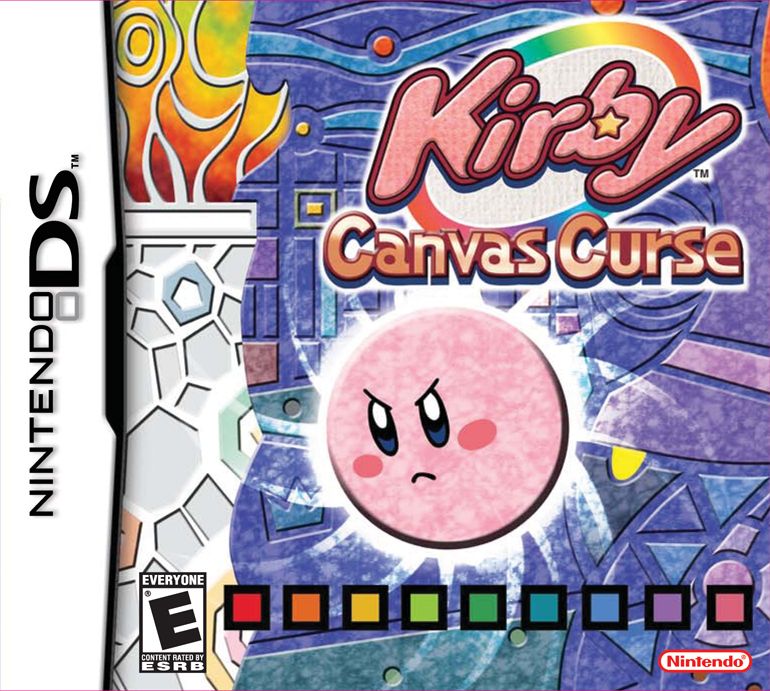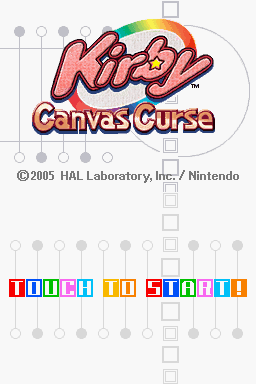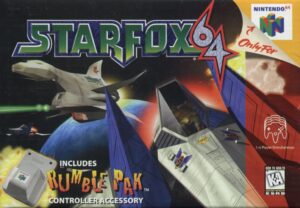Retro Replay Review
Gameplay
Kirby: Canvas Curse reinvents the platformer genre by replacing traditional controls with the DS’s stylus. Instead of pressing buttons to move Kirby, you draw paths and walls directly on the touch screen to guide him through each level. The core mechanic of sketching ramps, barriers, and loops feels intuitive from the very first tutorial stage, turning your stylus into a magic paintbrush that breathes life into the world.
As you guide Kirby’s ball form, you’ll encounter a variety of enemies that require different strategies. Tapping foes stuns them, creating opportunities to dash Kirby into them for damage. You can also draw protective shields or slopes to evade projectiles. This layered interaction keeps encounters engaging, blending fast-paced planning with the tactile satisfaction of painting your way to victory.
Kirby’s iconic copy abilities add another dimension to the gameplay. Defeating certain enemies grants temporary powers—like transforming into a stone to crush obstacles, inflating like a balloon to float, or turning into a speedy tire. Choosing when and where to use these abilities enhances your tactical options, encouraging experimentation and creative problem-solving as you progress through the seven worlds.
Replayability shines thanks to collectible Medals hidden in each stage, rewarding precision and exploration. After conquering the main campaign, Rainbow Run challenges you to set records by completing levels rapidly and with minimal stylus strokes, injecting a speedrunning spirit into the experience. Additionally, Subgames unlock various mini-challenges that test your dexterity and timing, offering a well-rounded suite of modes that extend the game’s longevity.
Graphics
Although constrained by the DS’s hardware, Kirby: Canvas Curse delivers vibrant, cartoon-like visuals that pop on the dual screens. Character sprites are crisp and expressive, with Kirby’s signature pink hue standing out against the game’s diverse backdrops. From lush forests and sparkling caves to mechanical fortresses, each environment is rendered with charming detail and a playful color palette.
The game’s UI is elegantly integrated into the art style. The bottom touch screen serves as both a canvas and an action zone, while the top screen provides a clean overview of Kirby’s position and health. Transitions between screens feel seamless, ensuring you can focus on drawing strokes without fumbling through menus or obscuring important information.
Enemy and boss designs maintain Kirby’s trademark whimsy, blending cuteness with quirky animations. Boss encounters are especially delightful—the oversized foes react dynamically to your drawn obstacles, slipping and sliding in exaggerated fashion. These larger-than-life battles showcase the DS’s ability to handle fluid character movements and colorful particle effects without noticeable slowdown.
Special effects, like the glittering trail behind Kirby’s paintbrush or the burst of sparkles when collecting a Medal, add polish and reinforce the game’s magical theme. While not pushing the DS to its limits, the graphics remain consistently charming and functional, enhancing gameplay clarity and aesthetic appeal.
Story
The narrative of Kirby: Canvas Curse is simple yet endearing. An evil witch named Drawcia transforms Kirby into a helpless ball, scattering paint across Dream Land in the process. Left with only a Magic Paintbrush—your stylus—you embark on a quest to restore Kirby’s form and stop Drawcia’s malevolent scheme.
Story beats are conveyed through brief cutscenes and expressive boss animations rather than lengthy dialogue, keeping the pace brisk and accessible to players of all ages. The minimalistic storytelling lets gameplay shine, using visual cues and charming character expressions to convey Kirby’s determination and Drawcia’s mischief.
As you traverse seven worlds, each with its own thematic flair, small narrative touches—like environmental changes after defeating mid-level bosses—give a sense of progression and reward. While hardcore gamers may crave deeper plot twists, the lighthearted tale perfectly complements the game’s design philosophy: whimsical fun, unburdened by complexity.
Ultimately, the story serves as a delightful framework for the innovative mechanics. It strikes a balance between cute aesthetics and goal-driven adventure, making it easy for newcomers to jump in while still satisfying long-time Kirby fans with familiar characters and motifs.
Overall Experience
Kirby: Canvas Curse stands out as one of the Nintendo DS’s most inventive titles, transforming the console’s touch capabilities into a fully realized gameplay mechanic. By swapping buttons for brushstrokes, the game offers a refreshingly tactile platforming experience that remains engaging from start to finish.
The balance of accessible learning curves, collectible challenges, and time-trial modes caters to both casual players and completionists. Medals and Rainbow Run encourage replay, while Subgames provide quick bursts of fun for those looking to master specific stylus-based skills. This variety ensures that the game remains compelling long after the main story concludes.
While the lack of traditional controls may deter purists, the intuitive design and immediate responsiveness of the stylus make the shift feel natural. Graphically, the game is a delight, leveraging the DS’s strengths to deliver crisp visuals and playful animations. The story, though simple, adds charm without overwhelming the core gameplay loop.
Overall, Kirby: Canvas Curse is a shining example of creative design on the DS platform. Its unique mechanics, coupled with colorful art direction and solid level design, make it a must-play for anyone seeking an innovative twist on classic platforming. Whether you’re a long-time Kirby fan or new to the series, this magical paint-and-roll adventure offers a thoroughly enjoyable journey.
 Retro Replay Retro Replay gaming reviews, news, emulation, geek stuff and more!
Retro Replay Retro Replay gaming reviews, news, emulation, geek stuff and more!





Reviews
There are no reviews yet.